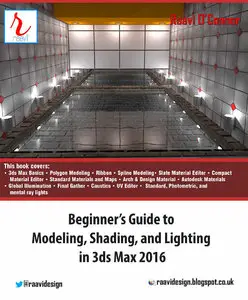Beginner's Guide to Modeling, Shading, and Lighting in 3ds Max 2016 by Raavi O'Connor
English | Jan. 26, 2016 | ISBN: 1523705310 | 460 Pages | AZW3/EPUB/PDF (conv) | 66.14 MB/50.79 MB/79.71 MB
English | Jan. 26, 2016 | ISBN: 1523705310 | 460 Pages | AZW3/EPUB/PDF (conv) | 66.14 MB/50.79 MB/79.71 MB
The Beginner’s Guide to Modeling, Shading, and Lighting in 3ds Max 2016 offers a hands-on exercises based strategy for all those digital artists [no experience required] who have just started working on the 3ds Max and interested in learning modeling, shading, texturing, and lighting in 3ds Max. This brilliant guide takes you step-by-step through the whole process of modeling, shading, and texturing. All tools, features, and concepts are discussed in detail.
In this book, the author has covered polygon and spline modeling techniques, modeling processes using Ribbon, material editors, Autodesk Materials, standard materials/maps, and mental ray’s Arch & Design material. A better understanding of materials and maps gives you ability to add realism to your artwork. Also, the author has covered standard, photometric, and mental ray lights. The concepts you will learn using this book will immensely help you in creating realistic looking models.
What You Will Learn?
• Navigating the workspace
• Customizing the interface and understanding various UI components
• Working with the file management commands
• Understanding workspaces
• Understanding the enhanced menu system
• Using the navigational gizmos
• Polygon modeling techniques
• Modeling and painting processes using the Ribbon
• Spline modeling techniques
• Effecting use of modifiers
• Working with the useful but less talked about tools
• Efficiently use Compact and Slate material editors
• Create shading networks using material editors
• Quickly apply shading to models using the Autodesk Materials
• Create variety of shading models using mental ray’s Arch & Design material
• Learn the mental ray’s features such as Global Illumination, Final Gather, and Caustics
• Work with UVs using UV Editor
• Standard, photometric, and mental ray lights



